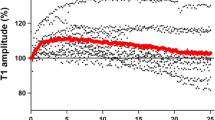Abstract
Purpose
We compared probabilities of tactile detection of fade in response to train-of-four (TOF). double burst stimulation,3,3 (DBS3,3). and DBS3,3 at the great toe with those at the thumb.
Methods
One hundred and thirty adult patients anaesthetized with nitrous oxide, oxygen, isoflurane, and fentanyl were studied. At varying degrees of neuromuscular block caused by vecuronium. an observer determined the presence or absence of fade m response to TOF, DBS3,3, or DBS3,2 at the great toe and that at the thumb. The relationship between TI /TO or TOF ratio (T4/T1) measured at the great toe and that at the thumb was also examined.
Results
When TOF ratios were 0-0,10, 0.11–0.20, 0.21–0.30, 0.31–0.40, 0.41–0.50, 0.51–0.60. 0.61–0.70. and 0.71-1,00. the probabilities of detection of fade in response to TOF at the great toe (thumb) were 77 (100), 66 (100), 58 (96), 52 (77), 39 (38), 26 (23), 2 (4), and 0 (0) %, respectively (P< 0.05 at TOF ratio 0–0.40). Similarly, the probabilities of detection of fade in response to DBS3,3 at the great toe were lower than at the thumb when TOF ratios were 0.21–0.80. and those in response to DBS3,3 at the great toe were lower than at the thumb when TOF ratios were 0.61–0.80. A dose relationship was observed between T1 /T0 or TOF ratio at the great toe and that at the thumb.
Conclusion
This study suggests that the probability of tactile detection of fade in response to TOF, DBS3,3, or DBS3,2 at the great toe is less than that at the thumb. The present results may be because the flexor hallucis brevis muscle is more resistant to non-depolanzmg neuromuscular relaxant than the adductor pollicis muscle and that the ratio of fade m response to neurostimulation at the great toe is higher than at the thumb.
Résumé
Objectif
Comparer les probabilités de détection tactile du fade au niveau du gros orteil en réponse au tramde-quatre (TOF). au double burst stimulation3,3 (DBS3,3) et DBS3,2 avec celles du pouce.
Méthodes
Cent trente adultes anesthésiés au protoxyde d’azote, oxygène, isoflurane et fentanyl participaient à l’étude. À différents niveaux de curansation obtenue avec du vécuronium, un observateur déterminait la présence ou l’absence de fade en réponse au TOF, DBS3,3 ou DBS2,3 au niveau du gros orteil ou du pouce. Le rapport entre T1 /T0 ou le rapport TOF (T1 /T4) mesurés aux deux endroits ont aussi été examinés.
Résultats
Quand les rapports TOF étaient 0-0, 10, 0,11–0, 20, 0,21–0.30. 0,31–0.40, 0,41–50, 0,51–0,60, 0,61–0,70, 0,71–0,80 et 0,71-1.00, les probabilités respectives de détection du fade en réponse au TOF au niveau du gros orteil (au niveau du pouce) étaient 77 (100), 66 (100), 58 (96), 52 (77), 39 (38), 26 (23), 2(4) et 0 (0)% (P< 0,05 au rapport TOF 0–0,40). De la même façon, les probabilités de détection du fade en réponse au DBS3,3 au gros orteil était inférieures à celles du pouce lorsque les rapport TOF étaient 0,21–0,80; celles de la réponse au DBS2,3 au gros orteil étaient inféneures à celles du pouce quand les rapports TOF étaient 0,61–0,80. Une relation étroite était observée entre T1 /T0 ou rapport TOF au gros orteil et au pouce.
Conclusion
Ce compte rendu suggère que la probabilité de détection tactile en réponse au TOF, DBS3,3, DBS3,2 au gros orteil sont inféneures à celles du pouce. Ces résultats pourraient signifier que le fléchisseur du gros orteil est plus résistant à un myorelaxant non dépolarisant que l’adducteur du pouce et que le ratio de fade au gros orteil en réponse à la neurostimulation est plus élevé qu’au pouce.
Similar content being viewed by others
Change history
29 April 2022
This article has been retracted. Please see the Retraction Notice for more detail: https://doi.org/10.1007/s12630-022-02254-9
References
Kitajima T, Ishii K, Kobayashi T, Ogata H. Differential effects of vecuronium on the thumb and great toe as measured by accelography and electromyography. Anaesthesia 1995; 50: 76–8.
Kitajima T, Ishii K, Ogata H. Assessment of neuromuscular block at the thumb and great toe using accelography in infants. Anaesthesia 1996; 51: 341–3.
Suzuki T, Suzuki H, Katsumata N, Shiraishi H, Saitoh H, Ogawa S. Evaluation of twitch responses obtained from abductor hallucis muscle as a monitor of neuromuscular blockade: comparison with the results from adductor pollicis muscle. J Anesth 1994; 8: 44–8.
Johnson MA, Polgar J, Weightman D, Appleton D. Data on the distribution of fibre types in thirty-six human muscles. An autopsy study. J Neurol Sci 1973; 18: 111–29.
Harper NJN, Martlew R, Strang T, Wallace M. Monitoring neuromuscular block by acceleromyography: comparison of the Mini-Accelograph with the Myograph 2000. Br J Anacsth 1994; 72: 411–4.
Viby-Mogensen J, Jensen E, Werner M, Kirkegaard Nielsen H. Measurement of acceleration: a new method of monitoring neuromuscular function. Acta Anaesthesiol Scand 1988; 32: 45–8.
Turner GA, Williams JD, Baker DJ. Train-of-four fade during onset and recovery of neuromuscular block: a study in non-anaesthetized subjects. Br J Anaesth 1989; 62: 279–86.
Author information
Authors and Affiliations
Additional information
This article has been retracted. Please see the retraction notice for more detail:https://doi.org/10.1007/s12630-022-02254-9
About this article
Cite this article
Saitoh, Y., Koitabashi, Y., Makita, K. et al. RETRACTED ARTICLE: Train-of-four and double burst stimulation fade at the great toe and thumb. Can J Anaesth 44, 390–395 (1997). https://doi.org/10.1007/BF03014459
Accepted:
Published:
Issue Date:
DOI: https://doi.org/10.1007/BF03014459




